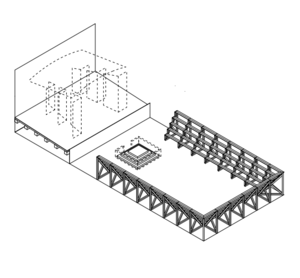Aims[edit]
By doing this workshop, you will:
- learn about the ideas and practices of Italian Renaissance and Baroque theatre
- develop your understanding of the architecture and technologies of the theatre building and stage by means of drawing
- learn to translate written descriptions of a theatrical space into 3D drawings through careful reading and understanding of the technology and the typological space
- extend your technical drawing skills using 3D modelling software
- have an opportunity to reflect on theatre, dramaturgy, architecture and scenic space
Key Information[edit]
| Number of learners | Up to 20, in groups of two or three students. |
| Number of staff | 1 Teacher |
| ECTS Credits (if applicable) | 5 credits |
Learning process[edit]
| Lecture/seminar | Lecture, presentation, discussion (face-to-face or online) | |
| X | Making project | Making a model, mock-up, plan or design (physical or digital) |
| Performance project | Making a performance or demonstration (live or mediated) | |
| X | Records and Archives | Interviews, photographs and videos of artefacts, annotating archives, creating learning materials (physical or digital) |
| X | Independent study | Reading, researching, analysing and evaluating learning materials (physical or digital) in groups or alone |
Type of learner[edit]
| X | Student of technical theatre |
| X | Student of theatre design, architecture |
| Student of theatre arts | |
| Professional | |
| X | Researcher |
| General public |
What You Will Need[edit]
Duration and schedule[edit]
The schedule is flexible. The project can be done as an intensive activity over 1-2 weeks, or as 10-15 weekly sessions with two hours for the learners to work on the text and drawing, and one hour discussion and feedback with the teacher.
The project can be shortened by drawing only selected parts of the theatre.
Room or type of space[edit]
Classroom. Alternatively, the project can be done online.
Equipment[edit]
Each student will need access to a computer with 3D drawing software such as SketchUp. A large screen or projector is useful for the teacher.
Materials (consumables)[edit]
Hand sketching materials are useful but not essential.
Learning resources (books, websites)[edit]
Canon stories:
- G.03 Scenography Codified: Serlio’s scenes for comedy, tragedy and satire
- G.04 How to build a Theatre: The books of Sabbatini and Furttenbach
Canonbase articles:
- Nicola Sabbatini
- Pratica di fabricar scene e machine ne' teatri – includes a link to an online version of the text
Process[edit]
Preparation[edit]
Prepare a short presentation about Sabbatini and the social, cultural and theatrical context he lived in. Also describe his book, Pratica di fabricar scene e machine ne' teatri.
The learning activity[edit]
Give a presentation to the students, introducing the project, Sabbatini and his book.
Students then research, read and translate into 3D drawings each chapter. At regular points during the process, review the drawings being produced and give feedback. In particular, discuss any ambiguities or contradictions in the text that students have found, and how they can be resolved.
Consider how the drawings can show aspects that might not follow Sabbatini’s text exactly, or which are uncertain, through the use of colour, for example. Explore how the drawings can be presented to best communicate the technical construction and the design intentions of the theatre to the viewer.
Once the drawing is complete, various extension tasks are possible, for example:
- Use a lighting visualisation software to light the theatre, either with simulated candlelight, or modern stage lighting
- Design a scenography for the theatre, based on the drawings of Sebastiano Serlio (G.03, Q568)
- Create a ‘fly-through’ video of the theatre space, with a commentary explaining the technical details of its construction.
Assessment and feedback[edit]
The project can be directly assessed in terms of students’ understanding of Sabbatini’s ideas as shown through the drawings, together with a discussion and Q&A session afterwards. Alternatively, students can be asked to write or present a reflection on their experience and learning.
Our Experience[edit]
Tips[edit]
Make sure students dedicate enough time to the research process before starting drawing. They should read fully the text, do some hand sketches beforehand and expand their reading with other examples.
The project can be expanded or reduced in time, according to your needs and available resources, by only drawing some parts of Sabbatini’s theatre. For example, you could leave out the auditorium.
Additional information and resources[edit]
This methodology has been used in the Canon project to develop a Teaching Tool – see Sabbatini in 3D.
Credits[edit]
| This learning method was made by: | Antoni Ramon, Guillem Aloy |
| Institution: | Universitat Politècnica de Catalunya. Barcelona Tech. |
